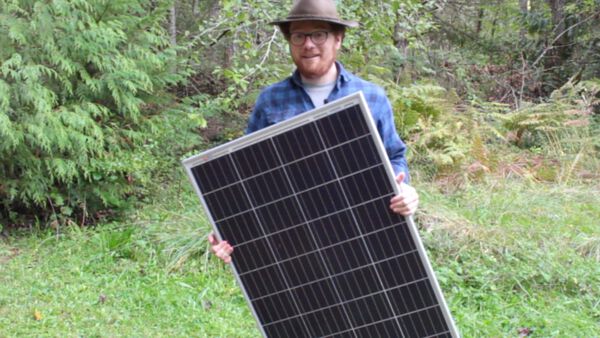There are a number of important factors to consider when deciding on a brand and type of solar panel to buy for your off grid solar system. The factors that manufactures hype often misleading, and can lead to you spending more than you had to, to build your DIY solar power system.
After considering many options from different suppliers, finding as many reviews as I can, and trying out a few options myself, I decided that the Rich Solar 100W Poly Panels are the best mix of quality, price, and size for a DIY off grid solar system.

The biggest take away from this article is to do your research. Don’t assume that “more efficient” is necessarily better for your design or that larger panels are more cost effective for small solar systems.
Choosing the Best Off Grid Solar Panel
All solar panel produce power, but there can be a lot more than price per watt to look at when considering which set of panels to go in for. Here are some things to consider:
- Price — Of course the price does matter. Panel costs per 1kW can vary by more than 30% from brand to brand and manufacturer to manufacturer. Choosing the right brand of solar panel for your DIY off grid system can save you hundreds or thousands of dollars depending on the size of your system. Be aware that larger panels can often be more expensive per W than 100W panels, which seem to be a happy medium. Don’t forget to factor in shipping. 200W+ panels are often to big and bulky to ship via normal carries, and incur an expensive additional freight shipping charge if you order them online.
- Durability — probably the biggest distinguishing factor between brands of solar panels is their case construction and durability. Having a rigid frame can increase the lifetime of your panels significantly, which in turn reduces the overall power cost of your system. Additionally, since off grid systems need to be reliable, it is important to factor in the failure rate of the panels when making a purchase.
- Size — for off grid homes, which favor rural environments, generally space is not an issue, and so panel coverage may be a secondary point. In most cases I recommend a cheaper poly-crystalline panel, since size efficiency is not important. However, if you are building an off grid RV or mobile tiny home, then you may want to spring for the slightly more expensive Rich Solar mono-crystalline 100W panels, which are about 10% smaller for the same power output. I only recommend this if your are able to squeeze in 1 or more additional panels because of the size difference.
- Convenience — if you are going to be installing your own system, then large panels may make the process of installing the panels much more difficult. To increase ease of handling, and to reduce chances of dropping and damaging a panel, I recommend the ~15 lb size of 100W panels over the 20–30 lbs of larger +200W panels.
- Replaceability — should you need to replace a panel, smaller panels will cost less. Since many of the 100W varieties are widely available online, including Amazon, you will be able to order a replacement that will arrive in 1–2 days, which is much faster than the 1–2 weeks required by suppliers of larger panels.
Brands to Consider
Below I’ve compiled a chart of readily available panels, including their cost per kilowatt hour.
| Panel Variety | Power (W) | Panel Cost | Cost/kW |
|---|---|---|---|
| Rich Solar Poly | 160 | $142.99 | $893.69 |
| Rich Solar Mono | 190 | $196.98 | $1,036.74 |
| Rich Solar Poly | 100 | $81.99 | $819.90 |
| Newpowa Poly | 100 | $82.00 | $820.00 |
| Renogy Mono | 100 | $99.99 | $999.90 |
| HQST Mono | 100 | $86.99 | $869.90 |
| DOKIO Mono Flex | 300 | $314.77 | $1,049.23 |
| BougeRV Mono | 170 | $154.99 | $911.71 |
Brand Comparison
All prices are current on Amazon as of the date of this posting (October 2019). Amazon prices change frequently, so please use this as a basis of comparison, and don’t depend on this chart to budget for your final system.
Of this list, Rich Solar and Newpowa 100W panels immediately jump out because they are the cheapest on the market. And, of the manufacturers on this list, Rich Solar and Renogy are probably the most established in the business.
Very likely, most of the cells themselves are produced China, potentially at one of a few different factories, if not the same factory. Therefore, one of the big considerations in fit and finish. Probably the best in this regard is Renogy, who provide high quality panels. However, compared to the quality of the rich solar builds, the improvement is not worth the extra cost in my opinion.
Rich Solar panels are not extravagant by any means, but the have a suitable strength and quality to their construction. That’s why I choose their most cost effective 100W mono panels for my own off grid solar system.
Can I Mix My Solar Panels
Depending on the type of controller, it is best not to mix the brands, or preferably age of your panels. MPPT charge controllers increase the efficiency of your panels by sensing and running your panels for the optimum current / voltage combination for their particular construction. They are most efficient if the efficiency curves of your panels are exactly the same.
Because the internal electrical construction varies from manufacturer to manufacturer, it is best to stick with one particular panel for your entire system. Mixing panels may result in less overall efficiency, because of mismatches between then two types.
However, if you plan to make a major addition to an existing solar system, now or in the future, you have the option of changing panel types/manufactures without loss of efficiency by also purchasing a second charge controller for your additional panels.
By running two or more charge controllers, each one with a potentially different variety of panels attached, you will not run in to loss of efficiency.
Poly-crystalline vs Mono-crystalline Panels
On the market, you see a two varieties of silicon being offered in the panel construction.
Mono-crystalline Solar Panels
Pros Mono-crystalline panels are the more high-tech option, where the “mono” comes from the fact the silicon manufacturing process is more selective for these types of panels. The biggest benefit is increased “efficiency” which means more light energy is converted to power, than with poly panels. However, what this really means is that you can produce a smaller panel for a particular power rating.
Some people say that mono panels are able to produce more light during overcast days, and near sunset and sunrise. However, there are other reports that difference is slight if any.
Cons The biggest negative point of mono-crystalline solar panels is the fact that they are more expensive for the same amount of power, compared to poly-crystalline panels.
Also because mono solar panels are both smaller and darker colored (their power generating surface is almost black rather than blue black), they may heat up more during the summer months. Solar panels produce less power when they are hot to the touch, and deeper thermal cycling probably reduces their lifespan (temperature is linked to early failure of solar panels.)
Poly-crystalline Solar Panels
Pros An older technology, poly panels are noticeably cheaper than their newer mono solar panel varieties. Price tends to be the major reason to stick with poly panels. Also, they also tend to be larger than mono for the same power production. If limited space isn’t an issue, then larger panel size has its benefits. Large panels potentially stay cooler because they have more surface area to exchange heat with their environment. Additionally, poly panels are not as dark in color as mono panels, so their per inch heat update is probably less.
Cons As said before, poly panels are larger, and so if space is the number one factor, then you probably better steer clear. Also, some reports say the poly panels do not perform as well as mono panels in low light conditions, although I have seen mixed reports about this.
What Are The Best High Wattage Panels Available
Based on my research, high wattage panels are not the best option for off grid, DIY systems. When factoring in total cost and delivery cost, even large scale commercial grade panels are not readily available at a lower cost per watt smaller than 100W panels.
In my price comparison, above, including research in to other wholesale panel suppliers that are not listed in the chart, 100W panels are the cheapest option available for us DIY builders who to not have access to professional level discounts.
Often, one of the biggest sources of expense for 200W plus panels is the shipping. These large panels are expensive to ship because they require freight carriers to move them. And, unless you have a business address with equipment to help unload, you will have to pay a hefty premium.
Another consideration is the difficulty and danger installing large panels. If you plan on installing these panels yourself, often on a roof or other high place, trying to maneuver a 30 pound panel difficult and dangerous with scaffolding and lifting equipment used by professional installers. By choosing the smaller 15 lb panels, I find that I am much more comfortable handling them on a roof in wind conditions.
For these reasons, I highly recommend 100W size panels over high wattage panels of 150W or more.
How Many Solar Panels Do I Need?
To get an accurate answer to that question, you need to determine how much energy you actually use. Check out my article Total Cost of Off Grid Solar Systems which walks you through the easy way to determine how many solar panels you need for your off grid solar system.
